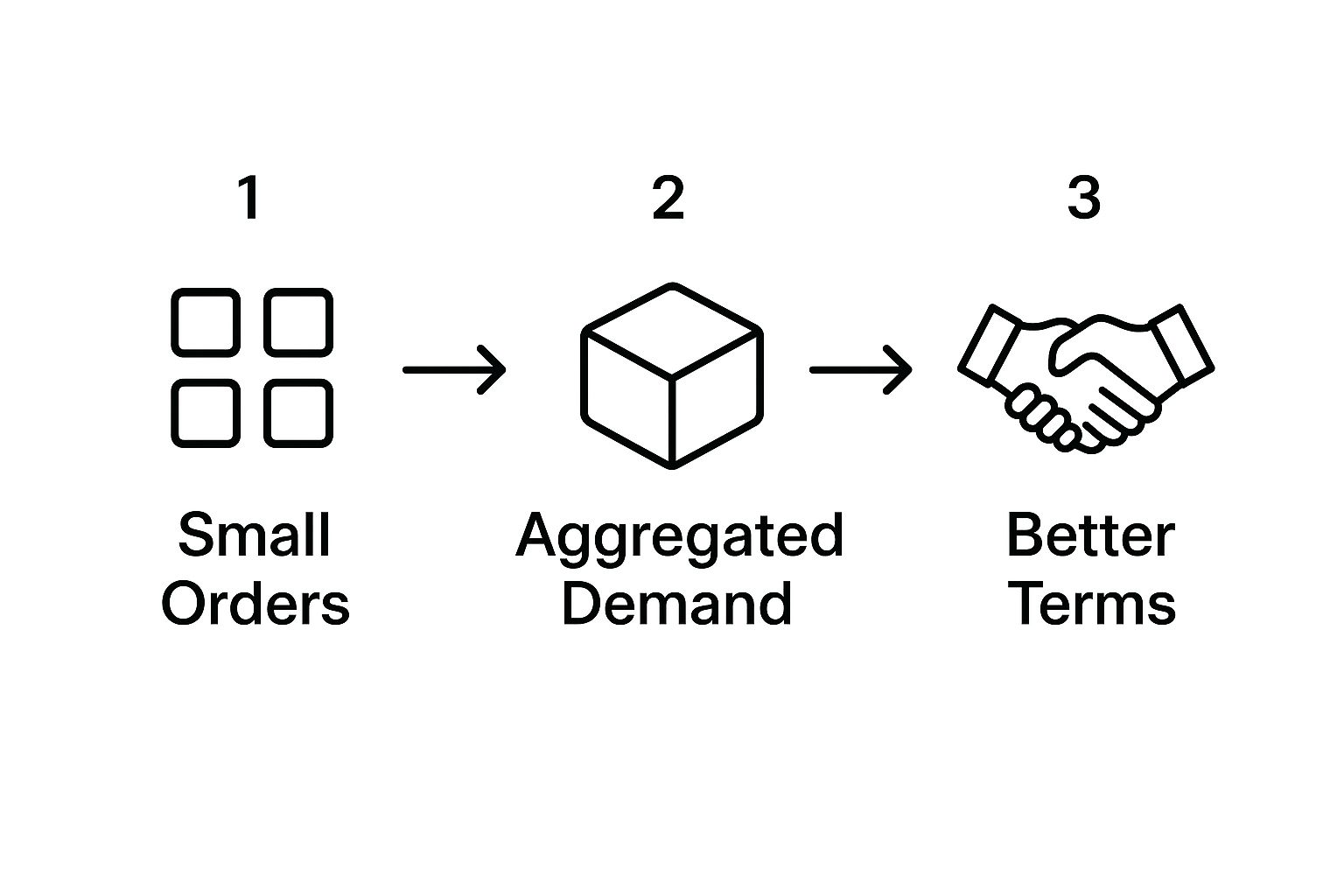
What Is Demand Aggregation and How It Works
Share
At its core, demand aggregation is all about pooling many small, individual purchase orders into a single, massive one. The goal? To get way more negotiating power with suppliers. Think of it as turning dozens of quiet requests into a single, powerful demand that suppliers can't ignore.
Unlocking Power Through Collective Buying
Let's use a simple analogy. Imagine a few families on the same street all want to install new solar panels. If each family contacts an installer on their own, they'll probably get the standard retail price. As individual customers, they have very little wiggle room to negotiate.
But what if they work together?
This is the very essence of what demand aggregation is. Instead of going it alone, the families combine their interest and approach the installer as one large customer. They're no longer just buying a few panels for one roof; they're offering a contract to outfit multiple homes at once. This completely flips the script.
All of a sudden, the installer sees a much more attractive deal—a guaranteed chunk of business with lower sales and marketing costs on their end. This gives the group the leverage to ask for better terms that were never on the table before.
This infographic breaks down the simple, yet powerful, flow of the process.

As you can see, the strategy takes scattered individual needs, bundles them into a single high-value order, and secures better terms from suppliers as a result.
Beyond A Simple Group Discount
It's easy to mistake demand aggregation for just a group discount, but it's much more strategic than that. A discount is typically a seller-initiated, one-off promotion. Aggregation, on the other hand, is a buyer-driven strategy designed to fundamentally reshape the negotiation. This idea shares a lot of DNA with group purchasing, where collaboration is the key to unlocking better value. If you want to dive deeper, our guide on what is group purchasing covers these foundational concepts in more detail.
The advantages go way beyond just a lower sticker price. When done right, aggregation can lead to:
- Better Contract Terms: Groups can push for things like better warranties, flexible delivery schedules, and higher service levels.
- Access to Higher-Quality Goods: To win a large, stable contract, suppliers are often willing to offer their premium products or services.
- Lower Transaction Costs: Managing one coordinated purchase is far more efficient than handling the administrative hassle of dozens of separate ones.
Demand aggregation isn't just a cost-saving tactic. It’s about creating stability in the market, shaping supplier behavior, and reducing risk for everyone involved.
By banding together, buyers offer suppliers a predictable and appealing sales pipeline. In return, suppliers can pass on savings because their own costs—from acquiring customers to planning production—are drastically reduced. It’s a win-win that turns a basic transaction into a strategic partnership, something individual buyers could never achieve on their own. This principle holds true everywhere, from local community co-ops to massive global industries.
Core Principles of Demand Aggregation
To really grasp how demand aggregation works, it helps to understand the fundamental principles that make it so effective. This table breaks down the core concepts.
| Principle | Description |
|---|---|
| Collective Power | The combined volume of the group creates negotiating leverage that no single member could achieve alone. |
| Reduced Risk | Suppliers gain a predictable, large-scale order, lowering their sales and operational risks. |
| Increased Value | Buyers can secure not only better prices but also superior terms, quality, and service levels. |
| Shared Efficiency | Consolidating the procurement process reduces administrative and transaction costs for all participants. |
These principles are the engine behind any successful demand aggregation strategy, enabling groups to transform their market position from passive price-takers to active deal-makers.
How Demand Aggregation Actually Works

It’s easy to grasp the basic idea of pooling demand. But how does it actually play out in the real world? It's not as simple as just getting a bunch of people together; there's a structured process that turns a lot of small, scattered needs into a single, powerful purchasing force.
At its core, demand aggregation is a strategic journey with a few distinct phases. It flips the script on the usual buyer-seller dynamic, moving from a one-on-one conversation to a many-to-one negotiation.
Let's walk through what that journey looks like.
Stage 1: Identifying the Common Ground
Everything starts with a simple realization: "Hey, you need that? I need that, too." This could be a cluster of small farms that all need new irrigation equipment, a group of marketing agencies that use the same pricey software, or several school districts hoping to buy new laptops for students.
This first phase is all about discovery. Potential buyers find each other and recognize they're all after the same thing, but their individual buying power isn't getting them very far. It's the initial spark that gets the whole thing moving.
Stage 2: Forming a Cohesive Buying Group
Once that shared need is out in the open, the next move is to organize. This is where interested parties come together to establish some ground rules. Communication is key here. Everyone needs to agree on product specs, quality standards, delivery timelines, and other important details.
This stage is all about building a solid foundation for the deal. The group could be an informal alliance of neighboring businesses or something more formal, like a consortium managed by an industry association. The objective is to create a single, unified voice to represent everyone's interests.
A well-organized buying group is more than just a list of names. It’s a unified entity with agreed-upon goals, clear requirements, and the collective will to negotiate as one.
Stage 3: Engaging an Aggregator or Platform
With a group formed and aligned, the next challenge is actually managing the negotiations and purchasing. This is where a central coordinator—an aggregator—steps in. An aggregator might be a third-party organization, an industry body, or a digital platform built specifically for this purpose.
The aggregator handles the heavy lifting, including:
- Consolidating Orders: Taking all the individual purchase requests and bundling them into one large-volume order.
- Vetting Suppliers: Finding and evaluating vendors who can actually handle an order of that size while meeting the group's quality standards.
- Leading Negotiations: Acting as the lead negotiator to secure the best possible price and terms for the entire group.
Platforms like AccountShare, for example, act as digital aggregators. They connect users who want to share access to a service and automate the whole consolidation process, which takes a huge administrative load off the individual members.
Stage 4: Finalizing and Fulfilling the Deal
This is where it all comes together. The aggregator finalizes the contract with the chosen supplier, making sure all the negotiated terms—from price per unit to delivery schedules—are locked in and legally sound.
Once the ink is dry, the supplier gets to work fulfilling the massive order. The aggregator often stays involved to manage logistics, ensuring every member of the group gets exactly what they paid for. In some cases, advanced production methods can make these large deals even more efficient. For instance, understanding the transformative impact of 3D printing on manufacturing and supply chain processes can add a layer of flexibility for customized, large-scale orders. This structured approach ensures a smooth, successful transaction from beginning to end.
The Strategic Benefits of Aggregating Demand
Sure, the most obvious win from demand aggregation is paying less, but that’s just scratching the surface. The real magic happens when you look beyond the initial discount. This strategy fundamentally changes the dynamic between buyers and suppliers, creating a wave of benefits that touch everyone involved—and sometimes even the entire market.
For buyers, it's all about gaining influence they simply couldn't have on their own. This shift is a game-changer, turning them from someone who just accepts a price into a group that helps shape the market.
Unlocking Superior Value for Buyers
The benefit everyone talks about is, of course, enhanced negotiation power. When you walk up to a supplier with a single, massive order instead of a bunch of small ones, you immediately become a top-tier client. That kind of leverage opens the door to serious cost savings that are impossible to get when you’re buying solo.
But the perks don't end with a lower price. Aggregating demand often unlocks access to higher-quality products or premium service levels that were once only available to massive corporations. Suppliers are far more willing to roll out the red carpet when they're competing for a big, stable contract.
It also massively cuts down on transaction costs for each individual. Think about it: instead of dozens of people running their own purchasing processes—with all the paperwork and time that takes—it all gets streamlined into one efficient operation. This is a huge part of increasing operational efficiency because it frees up people to focus on more important work.
And in today's world of shaky supply chains, a collective agreement can be a lifesaver. A large, long-term contract gives buyers more predictable and stable access to the things they need, protecting them from sudden price spikes and shortages.
By pooling their needs, buyers don't just get a better price. They gain access, stability, and efficiency that fundamentally strengthen their operational resilience.
Creating Stability and Growth for Suppliers
This isn't a one-sided deal, either. Suppliers love this model, and for good reason. The biggest advantage for them is a predictable and stable revenue stream.
A single, large order from a group gives them a reliable sales forecast. This lets them plan their production runs and manage inventory with incredible accuracy, reducing their financial risk and smoothing out the usual business ups and downs.
This stability leads straight to another huge win: much lower customer acquisition costs. Instead of pouring money and effort into chasing dozens of small leads, a supplier can land a huge chunk of business in one fell swoop. That efficiency is a direct boost to their bottom line.
Most importantly, large and consistent orders help suppliers achieve economies of scale. This is the classic principle where making more of something lowers the cost of each individual item. It’s the bedrock of efficient production. You can dive deeper into this idea in our guide on what is economies of scale. Those savings can then be shared with the buyers, creating a positive feedback loop where everyone wins.
Broader Market and Industry Impacts
The ripple effect of demand aggregation can be felt across an entire market. It often acts as a spark for progress and innovation.
For instance, when a large group comes together and demands a product with specific features or higher ethical standards, it sends a clear and powerful signal to the industry. This can speed up the adoption of new technologies or push everyone to follow better practices. We see this in sectors like renewable energy, where collective demand is making green tech more affordable and widespread.
Ultimately, demand aggregation takes a messy, fragmented process and turns it into a coordinated force for good. It empowers buyers, provides stability for suppliers, and nudges whole industries toward a more efficient and innovative future.
Driving Sustainable Change in Heavy Industry

Demand aggregation isn't just a clever way to save a few bucks; it's a powerful engine for real environmental progress. This is especially true for heavy industries like steel, cement, and shipping—sectors that have always been incredibly tough to decarbonize.
These industries are stuck in a classic "first-mover" trap. No single company wants to be the guinea pig, sinking billions into unproven green technologies. The risk is just too massive for one organization to shoulder alone. Think about it: a shipping company that commits to expensive green ammonia-fueled vessels has no real guarantee the fuel will even be available, let alone affordable. In the same boat, a steel producer who invests in green hydrogen has no idea if buyers will actually pay a premium for their low-emissions steel.
This is where understanding what is demand aggregation becomes the key to unlocking the whole puzzle.
Overcoming the First-Mover Dilemma
Demand aggregation shatters this stalemate. By uniting multiple large buyers—think automakers, major construction firms, and logistics giants—it sends a clear, powerful, and unified signal to the market. Instead of suppliers seeing a few scattered, hesitant requests, they see one massive, bankable order for green materials and fuels.
That collective commitment completely flips the investment equation. It gives producers the confidence and financial security they need to actually build the infrastructure, whether that’s a new green steel mill or a sustainable aviation fuel refinery.
By pulling future demand together, aggregation acts as a market-shaping force. It provides the certainty needed to de-risk huge capital investments in green tech, finally making sustainable alternatives a commercially sound bet.
This is exactly the kind of collective action needed to get the ball rolling. Demand aggregation is critical for speeding up the adoption of low-emissions products, particularly in energy-hungry sectors like cement, steel, maritime shipping, and aviation. These industries need enormous infrastructure investments to go green, but the demand for these new products is often too fragmented.
By pooling purchasing power, aggregation lowers the risk for those willing to go first and helps create economies of scale, making investments in the supply chain far more attractive. To put it in perspective, hitting net-zero in heavy industry will require nearly 600 low-emissions projects to begin construction globally before 2030. You can learn more about how collective demand powers the green transition on rmi.org.
Creating Economies of Scale for Green Tech
Just like with everyday products, demand aggregation for sustainable goods helps slash costs through economies of scale. Early-stage green technologies are usually expensive because they’re made in such small batches. A large, consolidated order gives producers the green light to scale up their operations, fine-tune their processes, and bring down the per-unit cost.
This kicks off a powerful virtuous cycle:
- Initial Aggregated Demand: A group of buyers commits to a large volume of a green product, like low-carbon cement.
- Supplier Investment: The producer takes this guaranteed demand to the bank, securing financing to build a large-scale, efficient production facility.
- Lower Production Costs: As production ramps up, the cost per ton of that green cement drops.
- Wider Market Adoption: The lower price point makes the sustainable option competitive with traditional materials, encouraging even more buyers to make the switch.
This is more than a business strategy. It's a collaborative way to hit our global climate targets. It empowers entire industries to change from the demand side up, turning individual purchasing decisions into a collective force for a greener future.
Real-World Examples of Demand Aggregation
It’s one thing to talk about demand aggregation in theory, but seeing it in action is where its true power becomes clear. This isn't some niche strategy; it’s a flexible approach you can find everywhere, from keeping our lights on to building massive skyscrapers and even buying software.
By looking at how different industries use it, we can see the same core idea of collective buying solving very different problems. Let's walk through a few examples that show just how versatile and effective it can be.
Stabilizing the Grid with Energy Aggregation
Perhaps one of the most critical uses of demand aggregation is in the energy sector, through what are known as demand response programs. Think about the challenge a power grid operator faces. They have to perfectly match electricity supply with what everyone is using, in real-time. On a scorching summer afternoon, millions of air conditioners kick on at once, creating a massive demand spike that can push the grid to its breaking point and cause blackouts.
Instead of building a brand-new, multi-billion-dollar power plant that would only run a few days a year, operators get clever. They use demand aggregation by partnering with companies that bring together hundreds or thousands of large energy users, like factories, warehouses, and office buildings.
Here’s how it works:
- The Signal: When the grid is under heavy stress, the operator sends out a call to reduce power usage.
- The Aggregator's Role: The aggregator then tells its network of participants to temporarily cut back. This might mean adjusting thermostats by a few degrees, pausing heavy machinery that isn't time-sensitive, or briefly switching to backup power.
- The Collective Impact: One factory powering down a machine doesn't do much. But when thousands of businesses do it at once, the combined effect is enormous. Together, they act like a "virtual power plant," freeing up huge amounts of capacity on the grid almost instantly.
The results are a win-win. The businesses that participate get paid for their flexibility, opening up a new revenue stream. The grid operator avoids a catastrophic failure and keeps the lights on for everyone without spending a fortune on new infrastructure. This market is booming—valued at around USD 2.85 billion, it's expected to reach nearly USD 8.7 billion by 2033. In 2021 alone, these programs helped slash peak electricity demand by almost 60 gigawatts (GW). You can explore more about the growing market for load aggregators on businessresearchinsights.com.
Managing Complexity in Large-Scale Construction
Now, let’s pivot to the world of construction. Picture a massive infrastructure project—a new airport terminal or a high-speed rail line. The amount of raw materials needed is staggering: tons of steel, concrete, wiring, and glass, all coming from dozens of different suppliers. The primary challenge is managing this incredibly complex supply chain while preventing costs from spiraling out of control.
This is a textbook case for demand aggregation. Instead of letting every subcontractor place their own separate, smaller orders for materials, the general contractor or a central procurement office steps in to consolidate everything. They pool all the steel requirements, all the concrete orders, and every other material into a master list.
By presenting a single, colossal order to suppliers, construction managers gain immense negotiating power. This not only secures better pricing but also guarantees supply, a critical factor in keeping massive projects on schedule and within budget.
This approach also ensures that the quality of materials is consistent across the entire project and makes the logistics far simpler to manage. For the suppliers, it’s a great deal, too. They get a large, predictable order that helps them plan their production and delivery schedules more efficiently. It’s a smart move that turns a potential logistical nightmare into a well-oiled machine.
Democratizing Access to Premium Software
In the tech world, small businesses and startups often feel like they’re playing on a different field. The powerful Software-as-a-Service (SaaS) tools that could supercharge their growth—like advanced marketing platforms or sophisticated CRMs—are often priced for huge enterprises. A single small company just doesn't buy enough licenses to get a discount.
This is where modern digital platforms like AccountShare step in, acting as tech-powered aggregators.
The model is elegantly simple:
- Identifying Shared Need: The platform spots a popular, high-cost software that lots of small businesses want but can't justify paying for alone.
- Creating a Buying Group: It brings these interested businesses together into a single group-buying pool.
- Negotiating as One: By representing the collective demand of the entire group, the platform can negotiate an enterprise-level subscription at a much lower per-user price.
This effectively breaks down the cost barrier, giving smaller players access to the same top-tier tools that their larger competitors use. It levels the playing field and proves how technology is making the powerful benefits of demand aggregation available to just about anyone.
Demand Aggregation Across Different Industries
The examples above are just the tip of the iceberg. Demand aggregation is a surprisingly adaptable strategy, applied in unique ways across various sectors to tackle specific challenges. The table below offers a comparative look at how it's put to work.
| Industry | Primary Goal | Key Outcome |
|---|---|---|
| Energy | Grid stability and peak load management | Avoided blackouts, reduced need for new power plants, new revenue streams |
| Construction | Cost reduction and supply chain simplification | Lower material costs, guaranteed supply, improved project timelines |
| SaaS/Software | Access to premium tools for smaller businesses | Affordable enterprise software, increased competitiveness for SMBs |
| Retail (Group) | Price reduction for consumer goods | Lower prices for individual buyers, increased sales volume for sellers |
| Healthcare | Lowering costs for medical supplies/drugs | Reduced procurement costs for hospitals, better pricing from manufacturers |
| Logistics | Optimizing freight and shipping capacity | Lower shipping costs, fuller trucks/containers, reduced carbon footprint |
As you can see, whether the goal is to prevent a power outage, build a bridge, or help a startup grow, the underlying principle remains the same: there is incredible strength in numbers.
How to Implement a Demand Aggregation Strategy

Putting theory into practice requires a clear roadmap. Launching a successful demand aggregation initiative isn’t a single action but a structured, multi-step process. This framework breaks down the journey from the initial idea to the final signed contract, giving you a real-world guide to unlocking collective buying power.
The first, and most critical, step is to identify potential partners. Start by looking for other organizations with purchasing needs that mirror your own. These could be businesses in your industry, companies in your local area, or even different departments within your own organization that are all buying the same things separately. The goal is to find that common ground where your needs overlap.
Once you have a list of potential allies, the real work of building a coalition begins. This is all about clear communication and establishing a solid structure for how the group will operate.
Establishing the Ground Rules
With a group of interested partners at the table, your next priority is getting everyone aligned. You need to transform from a loose collection of individual buyers into a cohesive unit with a single, powerful voice. Without this, negotiations will likely fall apart before they even get started.
To make that happen, focus on a few key areas:
- Standardize Specifications: Every member must agree on the exact requirements for the product or service. This means nailing down quality standards, features, and performance metrics that work for everyone.
- Define Clear Roles: Who's leading the negotiations? Who will be the point person for communicating with the supplier? Sorting out roles and responsibilities early on prevents a ton of confusion and helps you make decisions quickly.
- Create a Formal Agreement: A simple memorandum of understanding (MOU) can work wonders here. It outlines the group's goals, rules, and commitments, ensuring everyone is on the same page from the get-go.
A successful buying group isn't just a list of participants; it's a unified entity built on trust, transparency, and a shared commitment to a common goal. This foundation is non-negotiable for achieving the best outcomes.
Executing the Procurement Process
With a well-organized group, you’re ready to move into the procurement phase. The first task is to vet potential suppliers. Not every vendor is equipped to handle the scale of a large, consolidated order. It’s vital to find suppliers who have the capacity, reliability, and financial stability to deliver without cutting corners on quality.
Next up is negotiation. Armed with the leverage of your group's combined volume, you can push for more than just a lower price. This is your chance to secure better terms, like extended warranties, flexible delivery schedules, or stronger service-level agreements (SLAs). Proper planning is crucial; understanding effective resource allocation strategies can help your group manage its time and efforts for maximum negotiating impact.
Finally, don't overlook the logistics. Managing a huge order is a common hurdle, so get ahead of it. Establish a clear plan for delivery, distribution, and payment processing that works for every member of the group. Strong coordination is the key to a smooth and successful execution from start to finish.
Got Questions? We've Got Answers
To help tie everything together, let's walk through a few of the most common questions people have about demand aggregation. Think of this as a quick FAQ to clear up any lingering confusion and show how this strategy really works on the ground.
How Is This Different From a Simple Group Discount?
It's a great question, and the answer comes down to one thing: who's in the driver's seat.
A group discount is a reactive, one-off deal offered by a seller. They're trying to move inventory or hit a sales target, so they dangle a temporary price cut to get a bunch of people to buy at once. The power is still with them.
Demand aggregation, on the other hand, is a proactive strategy driven entirely by the buyers. You aren't just passively accepting a deal—you're actively pooling your purchasing power to create real leverage. This muscle allows you to negotiate far more than just the price; you can influence product features, contract terms, and even secure a more reliable supply chain.
The real difference is about intent and control. A group discount is about taking what a seller offers. Demand aggregation is about shaping the offer itself, turning buyers from price-takers into market-makers.
Is This Strategy Only for Huge Companies?
Not at all. While you definitely see massive corporations forming industry consortiums, the beauty of demand aggregation is that it's incredibly scalable. Thanks to modern digital platforms, the playing field has been leveled.
It’s now easier than ever for small and medium-sized businesses (SMBs) to team up and unlock the kind of buying power that was once out of reach. We see it happening everywhere:
- A group of local businesses might form a co-op to buy office supplies in bulk.
- A handful of startups could join forces to get a better rate on enterprise-level software.
- Neighboring farms might collaborate on purchasing expensive new equipment.
Technology has taken the headache out of the coordination, making it possible for almost anyone to benefit.
What Are the Biggest Challenges to Watch Out For?
The toughest parts are almost always coordination and alignment. It sounds simple, but getting a group of independent buyers to agree on the exact same product specs, delivery dates, and payment terms can feel like herding cats.
Building genuine trust among participants is non-negotiable, and you need a clear, agreed-upon process for making decisions. Without that foundation, things can fall apart quickly.
The other hurdle can be finding a supplier who is both willing and capable of handling a large, consolidated order. This is especially true if you’re trying to buy something highly specialized or niche.
Ready to stop overpaying for premium software and services? At AccountShare, we make it easy to join group purchases for top-tier subscriptions, giving you access to the tools you need at a fraction of the cost. Explore our offers and start saving today.
